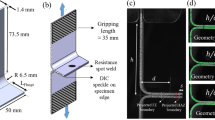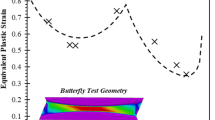Abstract
Small test coupons were machined from single spot welds in a dual-phase steel (DP600) to investigate deformation and failure of weld joints in both tension and shear. Quasi-static (\( \ifmmode\expandafter\dot\else\expandafter\.\fi{\upvarepsilon } \sim 10^{{ - 4}} \,1/{\text{s}} \)) testing was conducted in a miniature tensile stage with a custom image acquisition system. Strain accumulation in each weld was analyzed where fracture occurred, which was typically outside the fusion zone. A few shear test coupons that failed in the fusion zone were found to have the same spheroidal defects noted in previous work, and thus, severely limited weld strength and ductility. A novel strain mapping method based upon digital image correlation was employed to generate two-dimensional deformation maps, from which local stress-strain curves to failure were computed. As an important first step toward incorporation of material models into weld simulations, a preliminary finite element analysis of a tension test successfully reproduced the experimental results with material models for the base, heat-affected, and fusion zone materials generated from prior work.























Similar content being viewed by others
References
D.T. Llewellyn, D.J. Hillis, Review: Dual Phase Steel, Ironmaking and Steelmaking, 23(6), 1996, p. 471
M. Marya, K. Wang, L.G. Hector, Jr., and X.Q. Gayden, Tensile-Shear Forces and Fracture Modes in Single and Multiple Weld Specimens in Dual-Phase Steels, ASME J. Manuf. Sci. Eng., 2006, 128, p 287–298
W. Tong, H. Tao, X.Q. Jiang, N. Zhang, M.P. Marya, L.G. Hector Jr., X.Q. Gayden, Deformation and Fracture of Miniature Tensile Bars with Resistance-Spot-Weld Microstructures, Metall. Mater. Trans., 36A, 2005, p. 2651–2669
M. Marya and X.Q. Gayden, Development of Requirements for Resistance Spot Welding Dual-Phase (DP600) Steels, Part I: The Causes of Interfacial Fracture, General Motors R&D Center Technical Report No. 9885, 2004, Warren, MI
W. Tong, An Evaluation of Digital Image Correlation Criteria for Strain Mapping Applications, Strain 41(4), 2005, p. 167–175
B.W. Smith, X. Li, W. Tong, Error Assessment of Strain Mapping by Digital Image Correlation, Exp. Tech. 22(4), 1998, p. 19–21
W. Tong, Detection of Plastic Deformation Patterns in a Binary Aluminum Alloy, Exp. Mech. 37(4), 1997, p. 452–459
W. Tong, Strain Characterization of Propagative Deformation Bands, J. Mech. Phys. Solids 46(10), 1998, p. 2087–2102
W. Tong, An Adaptive Backward Image Correlation Technique for Deformation Mapping of a Growing Crack in Thin Sheets, Exp. Tech. 28(3), 2004, p. 63–67
N. Zhang, W. Tong, An Experimental Study on Grain Deformation and Interactions in a Binary Aluminum Alloy, Int. J. Plasticity 20, 2004, p. 523–542
W. Tong, H. Tao, Crack Tip Fields and Fracture Behavior in a NiTi Shape Memory Alloy Thin Sheet, Mater. Res. Soc. Symp. Proc., 785, 2004, p.D7.7.1–D7.7.6
W. Tong, H. Tao, N. Zhang, L.G. Hector, Time-Resolved Strain Mapping Measurements of Individual Portevin-Le Chatelier Deformation Bands, Scripta Mater. 53(1), 2005, 87–92
H. Tao, “Plastic Deformation and Fracture Behaviors of Resistance Spot-Welded Dual-Phase Steel and Laser-Welded Aluminum Sheet Metals.” Ph.D. Thesis, Department of Mechanical Engineering, Yale University, New Haven, Connecticut, 2006
M. Marya, L.G. Hector, R. Verma, W. Tong, Microstructural Effects of AZ31 Magnesium Alloy on its Tensile Deformation and Failure Behaviors, Mater. Sci. Eng. A418, 2006, p.341–356
W. Tong, L.G. Hector, Jr., C. Dasch, H. Tao, and X. Jiang, Local Plastic Deformation and Failure Behavior of ND:YAG Laser Welded AA5182-O and AA6111-T4 Aluminum Sheet Metals, Met. Mater. Trans. A (in press)
Acknowledgments
The authors are grateful to M. Marya for support with spot welding. Gary Jones and Tim Johnson of the GMR Engineering Design group prepared drawings for each coupon, and Warren Cavanaugh of the Pre-Production Operations group cut all of the coupons from individual spot welds with wire EDM.
Author information
Authors and Affiliations
Corresponding author
Appendix
Appendix
Four definitions of the average axial true strain measures were employed in this study. The corresponding mathematical definitions of the average strain measures are as follows:
where \( \ifmmode\expandafter\bar\else\expandafter\=\fi{\upvarepsilon }^{{(1)}}_{1} \) is the axial strain averaged over the entire gage section (following the conventional tensile test methodology), M and N are the total numbers of grid points along the gage length and width directions, respectively, and ε1(i, j) is the local axial strain at each grid point (i, j) obtained via DIC;
where \( \ifmmode\expandafter\bar\else\expandafter\=\fi{\upvarepsilon }^{{(2)}}_{1} \) is the axial strain averaged over the entire neck region (this is the lower bound estimate of average strain in the diffuse neck), M1 and Mn are the starting and total number of grid points along the gage length direction of the neck region, respectively;
where \( \ifmmode\expandafter\bar\else\expandafter\=\fi{\upvarepsilon }^{{(3)}}_{1} \) is the axial strain averaged along the bar cross section with the smallest width (i.e., the neck center line at I = M0), but not necessarily perfectly normal to the gage section;
where \( \ifmmode\expandafter\bar\else\expandafter\=\fi{\upvarepsilon }^{{(5)}}_{1} \) is the maximum axial strain at the center of a diffuse neck corresponding to the grid point (M0, N0). This definition of axial strain provides the upper bound estimate of measurable average strain in the diffuse neck. Since the entire gage section was used to compute \( \ifmmode\expandafter\bar\else\expandafter\=\fi{\upvarepsilon }_{1} ^{{(1)}} \), local strain heterogeneities were averaged out over the gage section. Alternatively, the strain fields selected for computing \( \ifmmode\expandafter\bar\else\expandafter\=\fi{\upvarepsilon }_{1} ^{{(2)}} \), \( \ifmmode\expandafter\bar\else\expandafter\=\fi{\upvarepsilon }_{1} ^{{(3)}} \), and \( \ifmmode\expandafter\bar\else\expandafter\=\fi{\upvarepsilon }_{1} ^{{(5)}} \), were measured over the entire neck region, or a selected part of the neck region, and hence local strain heterogeneities were more accurately quantified. Both analytical and numerical analyses have shown that the average axial true strains \( \ifmmode\expandafter\bar\else\expandafter\=\fi{\upvarepsilon }_{1} ^{{(2)}} \) and \( \ifmmode\expandafter\bar\else\expandafter\=\fi{\upvarepsilon }_{1} ^{{(3)}} \), as defined, respectively, by Eq A2 and A3, are the most accurate estimates of uniaxial true strain and true stress (via Eq 1) beyond diffuse necking in various tensile bar geometries (Ref 13). The definitions \( \ifmmode\expandafter\bar\else\expandafter\=\fi{\upvarepsilon }^{{(1)}}_{1} \) and \( \ifmmode\expandafter\bar\else\expandafter\=\fi{\upvarepsilon }^{{(5)}}_{1} \) provide uniaxial true stress-strain curves that bound the actual uniaxial true stress-strain curve irrespective of tensile bar geometry.
Rights and permissions
About this article
Cite this article
Tao, H., Tong, W., Hector, L.G. et al. Uniaxial Tensile and Simple Shear Behavior of Resistance Spot-Welded Dual-Phase Steel Joints. J. of Materi Eng and Perform 17, 517–534 (2008). https://doi.org/10.1007/s11665-007-9170-8
Received:
Revised:
Accepted:
Published:
Issue Date:
DOI: https://doi.org/10.1007/s11665-007-9170-8




